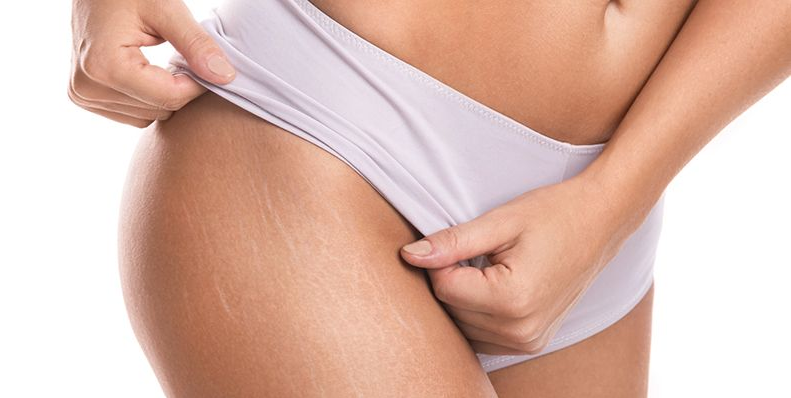Stretch marks are scars that form as a result of rapid stretching and recoiling of your skin. They form in the middle layer of the skin (the dermis) when the elasticity of its connective tissue is exceeded. This may cause the dermis to tear, which leads the inner layers of the skin to show through. Stretch marks often look like discolored parallel lines on your skin.
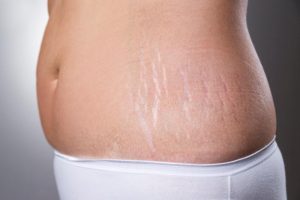
The color may look reddish initially but later progress to purple, pink, gray or silver. On touching, they may feel raised and sometimes even slightly itchy or swollen. They most often occur in areas where fat storage is high such as in the thighs, buttocks, breasts, abdomen, shoulders and upper arms.
What causes stretch marks?
Stretch marks usually occur during pregnancy, puberty or during periods of rapid weight gain or weight loss. It can also be the result of having excessive cortisone in your body. Cortisone is a hormone released from the adrenal glands, and having too much of it (for example in Cushing’s disease) can cause the skin to lose its elasticity.
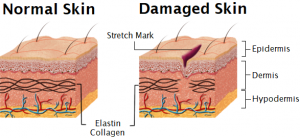
Although stretch marks are nothing to be scared about, they often cause people a lot of cosmetic dissatisfaction. But don’t worry, we’re here to help. With these easy tricks, getting rid of stretch marks will be an easy deal for you!
1. Topical creams and lotions
The application of topical creams, lotions and oils for stretch mark removal is perhaps the most popular technique. This is because these products is effective on everyone, regardless of gender or age. Most of these creams contain retinoid.

By increasing the rate of collagen and elastin production in the skin, these products promote skin growth. Along with this, your skin’s elasticity is also drastically amplified. It is also extremely convenient to use. All you have to do is massage the lotion/cream/oil onto the affected areas until it has been absorbed. You’ll start seeing marked improvement just within weeks!
2. Laser Therapy
Laser Therapy is another fast and popular technique for stretch mark removal. This method uses pulses of laser light which causes disintegration of the skin in the affected areas. The skin is then left to heal and newer, cleaner layers of skin are then formed. Pulsed Laser Therapy also helps stimulate the growth of collagen and elastin in your skin.
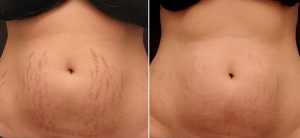
This technique usually takes about half an hour. You may require more than one treatment depending on the state of your stretch marks. However, the results are long-lasting, safe and satisfying. You should consult your doctor about which kind of laser treatment will work best for you.
3. Clinical Peels
In this method, an acidic solution is applied to your skin with the use of sponges, brushes or cotton pads. This causes the top layers in the affected areas to peel off- thus promoting skin regeneration. The three most common chemicals used in this process include phenol, glycolic acid and alpha-hydroxy acid. The chemical to be used is chosen according to your skin type and the characteristics of your stretch marks. However, this method is not as effective as the ones given above and my even cause burning and stinging during treatment. You can try it if the ones above don’t feel comfortable to you.
4. Microdermabrasion for Stretch Marks
As the name suggests, microdermabrasion is a method in which rough material is used to exfoliate the outer-most part of the skin. More often, it is done with a specialized gadget which removes the exfoliated skin through suction.

After the outermost layer is removed, the inner layers then are left intact. This means that the results are only temporary and repeated treatments are often required.
5. Platelet Rich Plasma (PRP) Injections
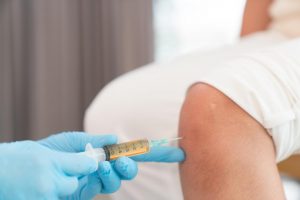
Platelet Rich Plasma is a concentrate of platelet-rich plasma protein that has been derived from whole blood after centrifuging it to get rid of the red blood cells.
It has shown to significantly increase the production of collagen and elastin in the areas in which it is injected. In this way it stimulates rapid skin repair.
6. Home Remedies for Stretch Marks
Home remedies for stretch marks can be an inexpensive solution. Although these remedies do not work for everyone, you might be one of the lucky ones. So do give it a try! Some popular home remedies for stretch marks include applications of aloe vera onto the skin. In addition to this, people also like to use sugar as a natural exfoliator.
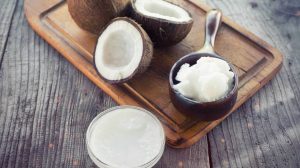
Coconut oil is also often applied onto the stretch marks as it has been shown to have healing properties. Furthermore, since vitamin A is known to promote healing, intake of foods rich in vitamin A such as carrots and sweet potatoes is also a great way to help get rid of your stretch marks.
7. Other Solutions
Self-tanning lotions can also be a useful way to hide stretch marks. However, this is just a temporary solution. Moisturizing creams also help accelerate skin repair by preventing dryness. In addition, they also relieve the itchiness caused by the stretch marks. It is best to start treating stretch marks as soon as they appear because newer ones are easier to erase.
Prevention of Stretch Marks in the Future
Stretch marks can be prevented in the future if you follow the tips below:
- Evaluate your BMI and maintain a healthy weight for yourself. Avoid rapid weight gain or weight loss. Keep it slow, but steady.
- Exercise regularly

Make sure you exercise regularly! - During pregnancy, consult the doctor about how much weight gain is optimum for you
- Intake adequate amounts of water. Stay hydrated!
- Make sure you have enough vitamins in your diet
- Consume foods rich in zinc

